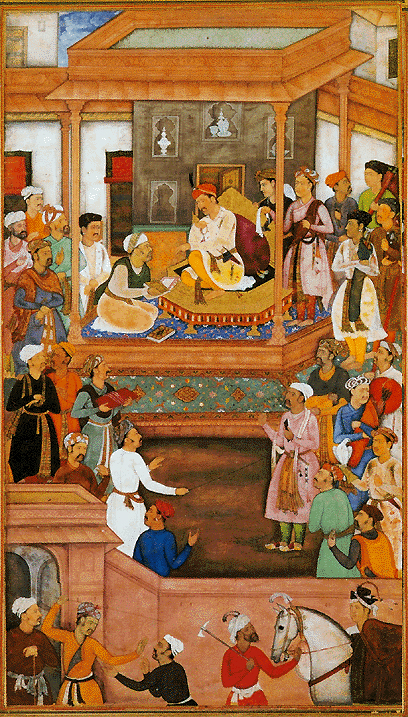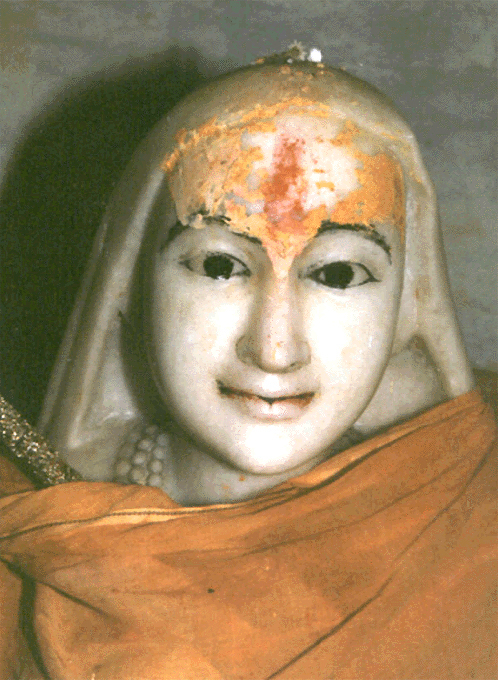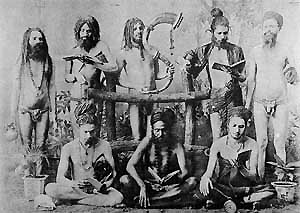
|
|
|
|
BY: SUN STAFF

Abu'l-Fazl presenting 'Akbarnama' to Akbar Jun 18, 2010 — CANADA (SUN) — A serial presentation of the Mughal effect on Vaisnava society. The Thaneswar conflict between Mughal
soldiers and fighting sadhus was not a singular event. While Akbar's intervention, or interference in the matters of these
religious groups appears to have had a great impact, it should be understood in the larger context of militarized clans of
sadhus, whose origination apparently had little to do with the arrival of the Mughal presence.
The Dasnamis described in yesterday's segment were but one manifestation of what was a long process of institutionalization of various camps of sannyasis and yogis. Today's Dasnamis claim they are descendents of Shankara, the 9th century acarya of Advaita. In the 14th century, the movement gained ground in Vijayanagar and began asserting its parampara links to Shankar. As these sannyasis gained influence in northern India, they began taking on titles identifying themselves as the das-nami, or ten-named enumeration. The evolution of Shankar's religious institution reflected in these ten group names – Tirtha, Asrama, Vana, Aranya, Giri, Parvata, Sagara, Sarasvati, Bharati, and Puri – was well underway by the time Akbar arrived on the scene. In Warrior Ascetics and Indian Empires, author William R. Pinch writes: "The generic quality of the tenfold enumeration and its relatively late arrival in descriptive accounts suggest that it was connected to a process of incorporation and institutionalization that was underway in northern India, namely, of regional varieties of ascetic practices and styles into a more cohesive, institutionally self-conscious monasticism. The bands of yogis who wandered the countryside – unruly, ash-besmeared, naked, armed and dangerous – would have posed an obstacle to this process of monastic institutionalization. The main hagiography of Shankar, the Shankaradigvijaya (the world-conquest of Shankara), confirms this apprehension. Authored by Vidyarana in the mid-fourteenth century, the text describes in a major concluding episode the strong (though fruitless) opposition offered to Shankara by one "Krakacha" and his followers, armed kapalika yogis, in what is now Karnataka. This contest of power is worth recounting in some detail, since it affords a picture of an armed ascetic band in the centuries just prior to Thaneswar." The tenfold names that were used as
classifications of the Dasnami lineage are indicative of place, geographic or social. Aranya and Van are terms
for the forest; Giri and Parvat refer to mountain; three names refer to generic ascetic places -- Puri
(settler), Asrama (hermitage), and Tirtha (shrine); and the last, Sagar, refers to ocean.

Adi Shankar Samadhi Murti, Kedernath The account of the Thaneswar battle given by Akbar's court historian, Abu'l Fazl, states that the two parties of warring sannyasis were the Kur and the Puri, and it was the Puri clan who benefited from the assistance of Akbar's soldiers. The name of the Kur (yogis) doing battle with the Puri sannyasis) is thought to come from 'gir', being the Giri camp. How these names were used in the various historical accounts of Thaneswar is important, because understanding who the two fighting groups of sadhus were help would help to clarify just what Akbar's role was in the matter, and to what degree the results of his intervention lead to later conclusions about how great Akbar's influence was on the various Hindu religious sects. William Pinch gives a further explanation on this point, referring to the names of the groups: "A giri-puri reading of Abu'l Fazi's narrative would suggest that the 1567 conflict was a Dasnami affair on both sides. This would be squarely at odds with the Dasnami sannyasi versus nath yogi interpretation argued by me and suggested by the remaining Mughal accounts. Another possible reading, however, is that Abu'l Fazl meant kur to be gor, as shorthand for "Gorakh" (or "Gorakhnath"), the yogi master who was, in competition with Shankara, being included in an increasing number of yogi guru genealogies after the twelfth century. Another possibility that does not preclude an affinity for Gorakhnath, is that the term kur was employed to link yogis to the broader geo-cultural associations of the Thaneswar setting. Introducing the event, Abu'l Fazl noted that "Formerly there was a wide plain there known as Kurkhet [from the Sanskrit Kurukshetra, the field of the Kurus] which the ascetics of India have reverenced from ancient times. This is, of course, a reference to the epic conflict known as the Mahabharata. Abu'l Fazl later noted that the "kurs" made an ancestral claim to the spot: "The Kurs represented [to Akbar] that the place belonged to them by inheritance, though the Puris had settled there for some time." (Likewise, one could speculate about the orthographic similarity between Kurkhet/Kurukshetr and Gorakh-khet/Gorakh-kshetra.) Badauni was more explicit about the
Mahabharata connections of Thaneswar, possibly because he was more familiar with the epic, having been ordered by the
Emperor [Akbar] to translate it into Persian. Acerbic juices in full flow, he observed that near Thaneswar, "at the lake
[called] Kurk'het, a host of Kurus and Pandus, (curse on them!) more than 4,000 years ago, according to the opinion of
the Hindus, to the number of seven or eight hundred millions of perons[,] were killed in a tumult (and they went by way of
water to hell-fire). Badauni, however, did not equate either combatant party with the ancient antagonists of the
Mahabharata.
One final point from Abu'l Fazl's narrative supports the identification of kurs as yogis. Abu'l Fazl describes the leader of the kurs using the Sufi designation, "pir": "They [the puris] came up with their [the kurs'] Pir and head, who was called Anand Kur, and slew the miserable creature." It is possible that Abu'l Fazl was simply employing a Sufi lexicon that would aid a Muslim reader in making sense of the scene. But it is worth noting that the term pir was (and still is) used by nath yogis to indicate the head of an ascetic band. Moreover, nineteenth-century observers reported that nath
yogis had formerly recruited noviates without regard to caste or religion and consequently attracted many Muslims, but
that this practice was, by the late 1800s, falling out of favor. Such Hindu-Muslim interpenetration among yogis (both
in terms of language and recruits) may have, over time, led Dasnami sanyasis to think of them as Muslims. This in turn
may help to explain the twentieth-century oral tradition that Akbar intervened to assist Hindu sanyasis against attacks
by Muslim fakirs."
| |
